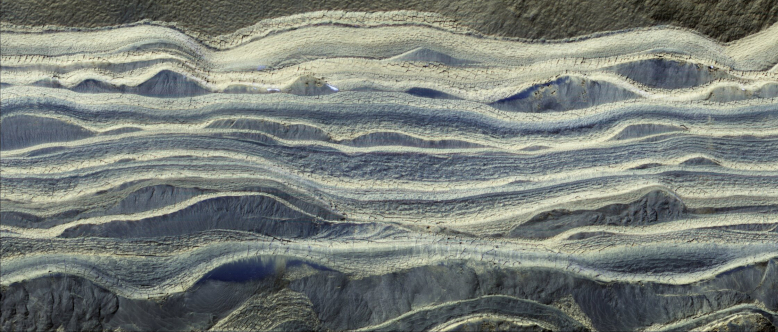Just as NASA awards research funding for in-situ resource utilisation on Mars, scientists at the University of Texas at Austin and the University of Arizona, uncover what is likely the third largest water reservoir on Mars after the polar ice caps.
The newly discovered water is of the frozen variety and is buried approximately 1.6 kilometres (1 mile) beneath Mars' north pole, sandwiched between layers of sand. If the ice were hypothetically to thaw out, it would cover the otherwise dry and dusty red planet with a global pool of water around 1.5 metres (5 feet) deep, say those who detected this massive martian ice depository.
Found by data gathered by the Shallow Radar (SHARAD) on NASA's Mars Reconnaissance Orbiter (MRO) that can peek up to 2.5 kilometres (1.5 miles) beneath the surface of Mars, this new find adds to the growing water budget concealed within the subsurface of our nearest planetary neighbour.
Just last year, a body of liquid water was found under Mars’ south pole, now with evidence that water is also sequestered under the North Pole, it can help to paint a picture of past climate on Mars.
The scientists behind the recent study, whose lead author is Stefano Nerozzi, a graduate research assistant at the University of Texas Institute for Geophysics (UTIG), think that the alternating layers of ice and sand are a result of retreating and advancing ice caps as the planet underwent periodic ice ages - much like Earth has experienced in the past.
In Mar’s case, after coming out of a particularly harsh cold spell and the planet grew warmer, sand was blown over any remaining ice sheets at the pole and this protective coating shielded the ice from the burning radiation of the Sun to prevent it from being lost into the atmosphere.
This recurring concealment process was so successful that the team found layers of sand and ice that were as much as 90 percent water in some places.
"Surprisingly, the total volume of water locked up in these buried polar deposits is roughly the same as all the water ice known to exist in glaciers and buried ice layers at lower latitudes on Mars, and they are approximately the same age," said co-author of he study Jack Holt, a professor at the Lunar & Planetary Laboratory of the University of Arizona.
Along with providing new and important insights into the exchange of water ice between the midlatitudes and the poles, this record of past polar glaciation could help determine whether Mars had enough water spread out across the planet to make it more habitable on a world-wide basis.
"Understanding how much water was available globally versus what's trapped in the poles is important if you're going to have liquid water on Mars," Nerozzi said. "You can have all the right conditions for life, but if most of the water is locked up at the poles, then it becomes difficult to have sufficient amounts of liquid water near the equator."
 A composite image showing alternating layers of ice and sand in an area where they are exposed on the surface of Mars. The photograph, taken with the HiRISE camera aboard NASA's Mars Reconnaissance Orbiter, was adjusted to show water ice as light-colored layers and sand as darker layers of blue. The tiny bright white flecks are thin patches of frost. Credit: NASA/JPL/University of Arizona
A composite image showing alternating layers of ice and sand in an area where they are exposed on the surface of Mars. The photograph, taken with the HiRISE camera aboard NASA's Mars Reconnaissance Orbiter, was adjusted to show water ice as light-colored layers and sand as darker layers of blue. The tiny bright white flecks are thin patches of frost. Credit: NASA/JPL/University of Arizona











